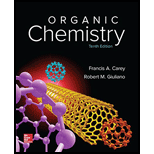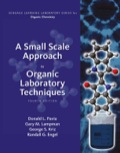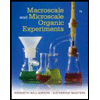
Organic Chemistry - Standalone book
10th Edition
ISBN: 9780073511214
Author: Francis A Carey Dr., Robert M. Giuliano
Publisher: McGraw-Hill Education
expand_more
expand_more
format_list_bulleted
Concept explainers
Textbook Question
Chapter 14.12, Problem 15P
Hydrogen bonding between the oxygen of dimethyl sulfoxide (DMSO) and the proton of an
Expert Solution & Answer
Want to see the full answer?
Check out a sample textbook solution
Students have asked these similar questions
Compare the 13C NMR spectra of isoborneol and camphor. Explain which peaks can be used to determine whether the oxidation was successful.
Propose a mechanism for this oxidation. To simplify the structures, use benzyl alcohol to draw the mechanism instead of isoborneol. Include the formation of any byproduct(s) in the mechanism.
What are the major IR bands, 1H-nmr signals, And the m/z of the following compounds
benzaldehyde
Following is a 1H-NMR spectrum of2-butanol, Explain why the CH2 protons appear as a complex multiplet rather than as a simple quintet.
Chapter 14 Solutions
Organic Chemistry - Standalone book
Ch. 14.3 - Prob. 1PCh. 14.3 - Prob. 2PCh. 14.4 - The 1H NMR signal for bromoform (CHBr3) appears at...Ch. 14.5 - identify the most shielded and least shielded...Ch. 14.5 - (a) Assign the chemical shifts 1.6, 2.2, and 4.8...Ch. 14.5 - Assign the chemical shifts 1.1, 1.7, 2.0, and 2.3...Ch. 14.5 - Assign the chemical shifts 1.6, 4.0, 7.5, 8.2, and...Ch. 14.6 - The 300-MHz 1H NMR spectrum of 1,4-dimethylbenzene...Ch. 14.6 - Prob. 9PCh. 14.6 - How many signals would you expect to find in the...
Ch. 14.7 - Describe the appearance of the 1H NMR spectrum of...Ch. 14.8 - Describe the appearance of the 1H NMR spectrum of...Ch. 14.11 - Prob. 13PCh. 14.11 - Prob. 14PCh. 14.12 - Hydrogen bonding between the oxygen of dimethyl...Ch. 14.14 - Prob. 16PCh. 14.15 - The 13C NMR spectrum of 1-bromo-3-chloropropane...Ch. 14.15 - Consider carbons x, y, and z in p-methylanisole....Ch. 14.15 - Prob. 19PCh. 14.16 - To which of the compounds of Problem 14.16 does...Ch. 14.18 - DEPT spectra for a compound with the formula...Ch. 14.20 - Vibrational frequencies are sensitive to isotopic...Ch. 14.21 - Prob. 23PCh. 14.22 - Prob. 24PCh. 14.23 - Prob. 25PCh. 14.23 - Which one of the C5H8 isomers shown has its max at...Ch. 14.24 - Knowing what to look for with respect to isotopic...Ch. 14.24 - The base peak appears at m/z105 for one of the...Ch. 14.24 - Mass spectra of 1-bromo-4-propylbenzene and...Ch. 14.25 - Prob. 30PCh. 14 - Each of the following compounds is characterized...Ch. 14 - Deduce the structure of each of the following...Ch. 14 - From among the isomeric compounds of molecular...Ch. 14 - The H1NMR spectrum of fluorene has signals at 3.8...Ch. 14 - Prob. 35PCh. 14 - H1NMR spectra of four isomeric alcohols with...Ch. 14 - Prob. 37PCh. 14 - We noted in Section 14.13 that an NMR spectrum is...Ch. 14 - Identify each of the C4H10O isomers on the basis...Ch. 14 - A compound (C3H7ClO2) exhibited three peaks in its...Ch. 14 - Label nonequivalent carbons in the following...Ch. 14 - Compounds A and B are isomers of molecular formula...Ch. 14 - C13 NMR spectra for four isomeric alkyl bromides...Ch. 14 - Prob. 44PCh. 14 - Prob. 45PCh. 14 - Identify the C3H5Br isomers on the basis of the...Ch. 14 - Prob. 47PCh. 14 - A compound (C8H10O) has the IR and H1NMR spectra...Ch. 14 - Deduce the structure of a compound having the...Ch. 14 - Figure 14.53 presents IR, H1NMR, C13NMR and mass...Ch. 14 - H1NMR, C13NMR, IR, and mass spectra are shown for...Ch. 14 - 1H NMR and IR spectra for a compound with the...Ch. 14 - FriedelCraftsalkylation of benzene with...Ch. 14 - Prob. 54DSPCh. 14 - Prob. 55DSPCh. 14 - Prob. 56DSPCh. 14 - Prob. 57DSPCh. 14 - Prob. 58DSP
Knowledge Booster
Learn more about
Need a deep-dive on the concept behind this application? Look no further. Learn more about this topic, chemistry and related others by exploring similar questions and additional content below.Similar questions
- Interpret the 1H NMR spectrum of Indole-3-Carboxaldehydearrow_forwardAssign peaks from 1500 to 2000 cm-1 for the IR spectrum of 3-acetoxybenzoic acid.arrow_forward5. How does the proton (¹H) NMR of the methyl benzoate reagent compare to the methyl 3-nitrobenzoate product? Include (or illustrate) the NMR plots and peak assignments for each.arrow_forward
- 2. Based on the NMR spectrum of the product from part B, did you obtain borneol, isoborneol, or a mixture? Explain. If you obtained a mixture of borneol and isoborneol, what was the percentage of each? Show your calculation below. Which isomer should have predominated (Isoborneol)? Why?Did your results confirm this?arrow_forwardInfrared Interpretation – interpret all absorptions in the 4000-1400 cm-1 region of the IR spectra of 2-methyl-4-heptanol. Label the recorded IR spectra and provide an indication of the impurities present, if any.arrow_forwardFigures 2 to 4 show the IR, 1H NMR and 13C NMR spectra of a compound with formula C3H5N 2a) Identify bands A and B in the IR spectrumarrow_forward
- In the 1H NMR spectra of 2-bromopropane (CH3)2CHBr and 1-bromopropane CH3CH2CH2Br, how many signals do you expect to see?arrow_forwardDefine the 1H NMR spectrum of 2-bromopropane, (CH3)2CHBrarrow_forwardWhat are the major IR bands, 1H-nmr signals, And the m/z of the following compounds methyl benzoatearrow_forward
- This is the spectral data for 4-cyclohexene-cis-1,2-dicarboxylic acid - Can you tell whether you have the cis or trans 4-cyclohexene-1,2-dicarboxylic acid based on the number of signals seen on 13C NMR?arrow_forwardGiven the H-NMR spectra, identify the peaks that can be represented for 2-Naphthyl-Butylether.arrow_forwardplease provide the mechanisims for the reactions of 1a ,1e,1farrow_forward
arrow_back_ios
SEE MORE QUESTIONS
arrow_forward_ios
Recommended textbooks for you
 EBK A SMALL SCALE APPROACH TO ORGANIC LChemistryISBN:9781305446021Author:LampmanPublisher:CENGAGE LEARNING - CONSIGNMENT
EBK A SMALL SCALE APPROACH TO ORGANIC LChemistryISBN:9781305446021Author:LampmanPublisher:CENGAGE LEARNING - CONSIGNMENT Macroscale and Microscale Organic ExperimentsChemistryISBN:9781305577190Author:Kenneth L. Williamson, Katherine M. MastersPublisher:Brooks Cole
Macroscale and Microscale Organic ExperimentsChemistryISBN:9781305577190Author:Kenneth L. Williamson, Katherine M. MastersPublisher:Brooks Cole

EBK A SMALL SCALE APPROACH TO ORGANIC L
Chemistry
ISBN:9781305446021
Author:Lampman
Publisher:CENGAGE LEARNING - CONSIGNMENT

Macroscale and Microscale Organic Experiments
Chemistry
ISBN:9781305577190
Author:Kenneth L. Williamson, Katherine M. Masters
Publisher:Brooks Cole
NMR Spectroscopy; Author: Professor Dave Explains;https://www.youtube.com/watch?v=SBir5wUS3Bo;License: Standard YouTube License, CC-BY